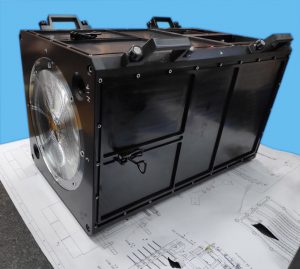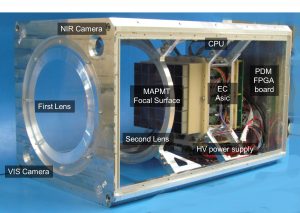
Mini-EUSO is leaving for Russia – for the final verification tests – and later for the Baikonur base (Kazakistan). It is an instrument aimed at studying and monitoring ultraviolet (UV) nocturnal emissions of terrestrial, atmospheric and cosmic origin, observing transient atmospheric phenomena, meteors and signals of matter made of strange quarks (Strange Quark Matter), and tracking space debris in orbit.
Mini-EUSO is a state-of-the-art telescope composed of two Fresnel lenses of 25 cm of diameter, a focal plane for collecting light made of 36 multianode photomultipliers, two mini cameras (one operating in the visible spectrum, the other in the near-infrared), and a compact electronic acquisition system (for a total weight of 30 kg). On next 22nd of August it will be launched from the Baikonur Cosmodrome with a Soyuz shuttle towards the International Space Station (ISS) and placed in the Russian module “Zvezda” to perform a series of night observations from the ISS altitude (about 400 km). It will be operated – inter alia – by the ESA astronomer Luca Parmitano during his stay aboard the station.
Mini-EUSO, realized by the International Collaboration JEM-EUSO, is the result of a ASI-INFN-Roscosmos (the Russian Space Agency) agreement, to which different INFN Sections participate, including the LNF, where many of the assembly, calibration and integration stages were carried out, as well as the realization of the entire mechanical structure that is qualified for space. These activities were coordinated by the SPCM Service, both for the qualification engineering model and the flight one.
To learn more: http://jem-euso.roma2.infn.it/?page_id=818

Translation by Camilla Paola Maglione, Communications Office INFN-LNF
 INFN-LNF Laboratori Nazionali di Frascati
INFN-LNF Laboratori Nazionali di Frascati